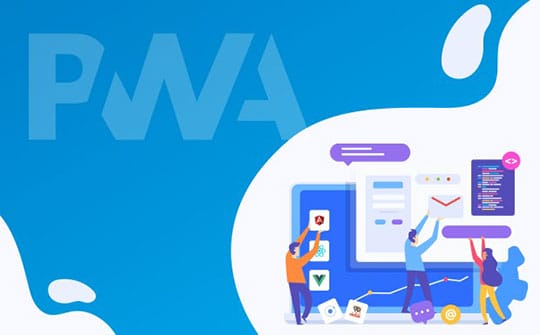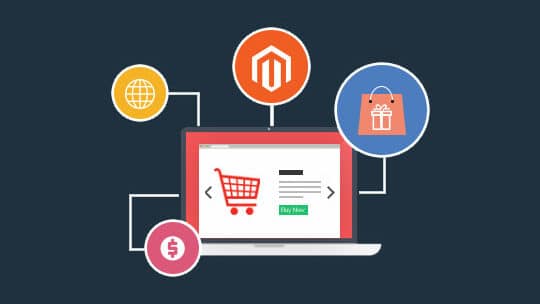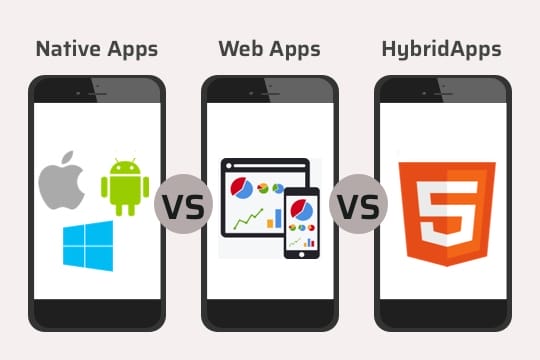In this day and age of online retailing, one thing is certain: the need for smooth mobile shopping experiences cannot be emphasized enough. As mobile commerce is set to cover more than 60% of all eCommerce transactions by the year 2025, how customers will interact with online stores on their mobile devices is now an important determinant of business success.
For Magento webshop owners, this reality offers an important choice point: do you go for a Progressive Web App (PWA), do you build a native mobile app or both?
This choice is not an easy one. As Magento development specialists, we’ve helped many companies to optimize their Magento store by navigating through the process of deciding between PWA and native app solutions to meet particular business requirements.
In this in-depth guide, we’ll delve into both alternatives in great detail, making it easy to compare them and offer real-life frameworks to enable you to decide which solution suits your eCommerce business best.
Understanding Progressive Web Apps (PWAs)

Progressive Web Apps are websites constructed using newer web technology that supply more functionality, reliability, and user interaction features normally found in native apps.
The key features that define PWAs are:
- Responsiveness: PWAs are incredibly easy to adjust to any screen size, whether it’s a desktop monitor or a smartphone.
- Connectivity independence: They have the ability to work offline or with intermittent network conditions thanks to service workers.
- App-like experiences: PWAs provide smooth scrolling and animations just like native applications.
- New content: Background updates guarantee fresh content.
- Safety: PWAs are delivered through HTTPS, securing data.
- Discoverability: As compared to native apps, PWAs can be discovered via search engines.
- Installation: Users are able to “install” PWAs on the home screen without the app store middlemen.
- Linkability: PWAs are shareable via URL, with no need for downloads.
Magento PWA Studio: Built-Purpose for eCommerce
Seeing the potential of PWAs to revolutionize eCommerce, Magento (Adobe Commerce) created PWA Studio, a dedicated toolkit meant to assist developers in creating PWA storefronts driven by Magento’s strong backend. PWA Studio offers developers:
- A PWA build pack with developer tools.
- Peregrine library with React hooks and components.
- Venia storefront (reference implementation).
- UPWARD (Unified Progressive Web App Response Definition).
- PWA extensibility framework for customization.
This toolkit greatly simplifies the development process, enabling faster implementation than creating a PWA from the ground up. For store owners in Magento, this is a significant benefit when taking into account the PWA strategy.
Important Advantages of PWAs for Magento Stores
PWAs provide several benefits that make them highly suitable for eCommerce businesses:

1. Smooth User Experience
PWAs load immediately and react instantaneously to user input, removing the friction that comes with slow-loading mobile websites. This instant response improves customer experience and lowers bounce rates. Research indicates that for each second of mobile page load delay, conversions can decrease by as much as 20%.
2. No Installation Barrier
In contrast to native apps, PWAs do not need users to go to an app store, find the application, wait for it to download, and then install it—a process that involves great friction and abandonment. PWAs can be accessed instantly via a web browser and added to the home screen with one tap.
3. Cross-Platform Compatibility
With just one PWA implementation, you can serve users across all devices and platforms, without the necessity to create and maintain independent applications for iOS and Android. Cross-platform capability cuts development expenses as well as maintenance overhead by a wide margin.
4. Automatic Updates
PWAs update automatically each time users visit them, so they always see the latest version. This removes update notifications and the user friction of having to manually update an app, while all users get the newest features and security safeguards.
5. SEO Benefits
PWAs are indexable in their entirety by search engines, so they can enjoy organic search traffic. This is a big marketing benefit since it taps into your current SEO investment to send traffic directly to your mobile experience.
6. Reduced Development and Maintenance Costs
Creating one PWA typically involves less investment compared to creating two distinct native apps for iOS and Android platforms. Maintenance costs are also usually lower because of the shared codebase.
7. Offline Capability
With service workers, PWAs can cache critical resources so that users can view previously visited products and content even offline. This feature is especially useful for customers in regions with poor network coverage.
8. Lower Storage Needs
PWAs take up very little storage space as compared to native applications, which is a major attraction for users with storage concerns regarding their devices, a specific issue for users of lower-end or older devices.
Native Apps for Magento Stores

Native apps are developed specifically for specific operating systems (mainly iOS and Android) with platform-specific programming languages and development tools. For iOS, this will most likely be Swift or Objective-C, and for Android development, Kotlin or Java is most commonly used.
For Magento store owners, native app development typically means developing a mobile app that communicates with your Magento backend via APIs. This creates a dedicated mobile experience entirely independent of your web presence.
Integration Options for Magento Stores
When developing native apps for Magento stores, several integration approaches are available:
1. Custom API Integration
This approach involves building custom applications that communicate with your Magento store through its API endpoints. While offering maximum flexibility, this method requires significant development expertise and time investment.
2. Third-Party Solutions
Several specialized vendors offer platforms that simplify the process of turning Magento stores into native apps. These solutions typically provide templates and modules specifically designed for eCommerce functionality, reducing development complexity.
3. Hybrid Frameworks
Platforms such as React Native or Flutter enable developers to code once and deploy to iOS and Android platforms. Although not strictly “native,” these strategies produce apps that emulate native performance and behavior very closely while cutting development time.
Key Advantages of Native Apps
Native apps provide a number of strong benefits that make them well-suited for some eCommerce use cases:

1. Better Performance
Native apps tend to provide the best possible performance on mobile, with smooth animation and responsive user interfaces. They are able to access device hardware directly without browser middlemen, which leads to best-in-class speed and responsiveness.
2. Full Device Integration
Native apps are able to take advantage of all device capabilities and hardware, such as cameras, GPS, accelerometers, and biometric authentication. This allows for high-end functionality such as barcode scanning, augmented reality product visualization, and secure biometric checkout flows.
3. Push Notifications
Although web push notifications are supported more widely, native apps have the most reliable and feature-rich push notification experience on all devices. These notifications are a significant marketing channel, with open rates commonly higher than 90%, as opposed to around 20% for email marketing.
4. App Store Presence
Placing your application in the Apple App Store and Google Play Store generates further discovery opportunities and adds credibility to your brand. App stores also offer a secure distribution channel that some customers prefer over web-based interactions.
5. Increased User Engagement
Research repeatedly indicates that users spend more time in native apps than on mobile websites. For eCommerce companies, this greater usage typically means greater average order values and more frequent purchases by app users.
6. Offline Functionality
Native apps can provide more robust offline functionality than PWAs, such as sophisticated features like offline shopping carts that sync when the connection is re-established.
7. Less Reliance on Browser Constraints
Native apps are not affected by browser limitations and capabilities and deliver more consistent experiences on every device and version of operating systems.
Making the Decision: Critical Comparison Factors

In making the decision between PWAs and native apps for your Magento store, there are some critical comparison factors to consider:
1. Development Costs and Resources
PWAs:
- Average expenditure: $20,000-$100,000.
- Shared codebase for all platforms.
- Web development skills required (JavaScript, React, service workers).
- Faster development time (typically 3-6 months).
Native Apps:
- Typical expenditure: $40,000-$120,000.
- Separate development for each platform.
- Needs specialist developers for every platform.
- Longer development process (usually 6-12 months).
2. Performance and User Experience
PWAs:
- Almost native-like performance with up-to-date browsers.
- Direct access without installation.
- Standard cross-platform experience.
- Limited use of device hardware.
- Part of the functionality depends on browser support.
Native Apps:
- Best performance and responsiveness.
- Full access to device capabilities.
- Platform-specific design language and interactions.
- Needs download and installation.
- Greater abandonment during acquisition.
3. Maintenance Requirements
PWAs:
- Single codebase to update.
- Automatic updates with no user intervention.
- No approval processes through app stores.
- Less impacted by OS updates.
- Typically lower annual maintenance fees (15-25% of the original development).
Native Apps:
- More than one codebase with updates needs to be synchronized.
- User intervention and app store approval are necessary for updates.
- Maintenance is needed regularly for OS support.
- Higher yearly maintenance fees (25-40% of the original development).
4. Marketing and Discoverability
PWAs:
- Accessible through web searches (SEO).
- Shareable and linkable.
- No need for an app store listing or optimization.
- Lower acquisition costs for users.
- Greater initial visibility through web searches.
Native Apps:
- Accessible through app stores.
- Requires App Store Optimization (ASO).
- Higher user acquisition costs.
- Lower search visibility.
- Better retention mechanisms once installed.
5. Business Model Considerations
Various business models are better suited to either PWAs or native apps:
PWAs are more suited to:
- Companies with high SEO traffic.
- Shops with irregular purchase behavior.
- Wider market coverage needs.
- Constrained development budget.
- Fast time-to-market demands.
- Content-intensive shopping experiences.
Native apps are more suited to:
- Loyalty-based business models.
- High-frequency purchase behaviors.
- Advanced personalization requirements.
- AR/VR shopping experiences.
- Complex offline functionality demands.
- High-value product categories where additional development investment is justified.
Decision Framework: Choosing the Right Approach

To determine whether a PWA or native app approach better suits your Magento store, consider this structured decision framework:
Step 1: Analyze Your Customer Base
- What percentage of your traffic comes from mobile devices?
- Which platforms do your customers primarily use?
- How technically savvy is your audience?
- How frequently do customers purchase from you?
Step 2: Evaluate Your Business Requirements
- Do you require access to particular device capabilities?
- How critical is the offline capability to your business?
- Is push notification support essential to your marketing initiative?
- How central is organic search traffic to your company?
Step 3: Evaluate Your Resources
- What development budget do you have available?
- Do you maintain recurring technical resources for upkeep?
- What is your implementation timeline?
- Do you already have experience in app store management and optimization?
Step 4: Evaluate Competitive Positioning
- What mobile experiences are your competitors providing?
- Is there a chance to differentiate using your mobile method?
- Would your customer base see additional value in a native app?
Step 5: Quantify Potential ROI
- Estimate customer lifetime value lift from enhanced mobile experiences.
- Estimate improvement in conversion rates based on industry norms.
- Estimate maintenance costs for 3 years.
- Compare the total cost of ownership between methodologies.
By going through this framework systematically, you’ll gain a better understanding of which method is more appropriate for your particular business setup.
Hybrid Approaches: The Best of Both Worlds?

It’s worth mentioning that the decision between PWAs and native apps is not necessarily a binary one. Most successful Magento merchants employ hybrid strategies that take advantage of the best of both worlds:
Sequential Implementation
Certain companies begin with a PWA deployment to enhance their mobile web experience in general, and later selectively build native apps for their most loyal segments of customers. This strategy enables:
- Innovative enhancement of mobile experience across all customers at once.
- Strategic development of native features for high-value user cases.
- Phasing of development costs over time.
- Data-informed decisions on native app features based on PWA usage behavior.
Feature-Based Segmentation
Another approach involves implementing a PWA for general shopping functionality while developing complementary native applications for specific features that benefit most from native capabilities, such as:
- Loyalty program management.
- AR product visualization.
- In-store navigation and inventory checking.
- Barcode scanning for quick reordering.
This strategy focuses on native development investments where they provide the clearest differentiation and value while maintaining the broad-reach benefits of a PWA.
Conclusion: Making Your Decision

The decision between PWAs and native apps for your Magento store isn’t about keeping up with industry trends—it’s about aligning technology choices with your particular business objectives and customer requirements.
PWAs provide a budget-friendly way to provide enhanced mobile experiences to your entire customer set with quicker implementation timelines and reduced maintenance burden. They are best at minimizing friction in the customer experience without sacrificing web presence SEO advantages.
Native apps deliver the best performance, device integration, and engagement features, but at greater development and upkeep costs. They excel in situations where customer loyalty, repurchasing frequency, and advanced functionality warrant the extra expense.
For many Magento merchants, the optimal approach may involve starting with a PWA implementation to elevate the baseline mobile experience for all customers, then selectively developing native applications for specific high-value segments or use cases where native capabilities provide clear differentiation.
As mobile commerce advances, the difference between web and native experiences will diminish. If you keep an eye on your particular business needs over concerns of technology, you’ll make decisions about how to implement that ensure significant business outcomes, whether you go with the path you choose or not.
The most effective mobile strategies are not characterized by technology decisions but by how well they address customer issues and eliminate friction from the shopping process. Whether via PWA, native apps, or a hybrid model, the key to success is always the same: delivering convenient, engaging shopping experiences that bring customers back.






